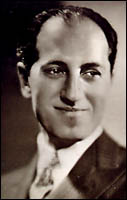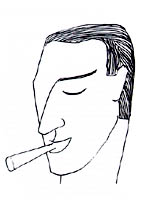Who Could Ask for Anything More?
A Century of George Gershwin
By Brandi Parisi
September, 1998
Unlikely Beginnings |
Early Career |
Getting Discovered
The Toast of the American Music Scene |
Final Curtain at the Height of Success
Music List from the Radio Broadcast
Recommended Recordings (Separate document)
 SIMULTANEOUS EAST AND WEST-COAST funerals took place on a muggy July
afternoon in 1937. Politicians, artists, entertainers, and musicians
gathered to mourn what was perhaps the greatest blow to American music in
history: the unexpected and untimely death of George Gershwin at 38.
SIMULTANEOUS EAST AND WEST-COAST funerals took place on a muggy July
afternoon in 1937. Politicians, artists, entertainers, and musicians
gathered to mourn what was perhaps the greatest blow to American music in
history: the unexpected and untimely death of George Gershwin at 38.
Whether or not Gershwin was the greatest American composer will always
be debated, but, beyond doubt, he was a most quintessential American
composer. An unlikely musical genius, he was a high-school dropout who,
by his own admission, was far more interested in roller skating and
cutting school - and making fun of kids who played instruments - than in
books or music. George Gershwin's story is the stuff of American romantic
folklore.
Unlikely Beginnings
He was Morris and Rose Gershwin's second son, born in Brooklyn, New York, September 26, 1898. As a child George was usually in some kind of
trouble. He despised reading and studying and instead spent his time
outdoors playing and getting into fights. His family purchased a second-hand
piano for elder son Ira when George was 12 years old, but it was
George, not Ira, who began playing songs by ear immediately, prompting the
family to invest in lessons.
Piano teacher Charles Hambitzer took George tuition free and taught him
the classics: composers such as Chopin, Liszt, and Debussy. Gershwin also
attended concerts voraciously, but, while his passion for music grew, his
interest in school did not. His grades continued to fall until, at 15, George dropped out of high school and took a job with Jerome H.
Remick & Company, a music-publishing firm on Tin Pan Alley, for $15 a week.
Early Career
At Remick George worked as a song plugger, promoting and selling the
company's songs by playing them for potential performers. Gershwin also
began to compose songs during this time though his employer discouraged
his writing. Regardless, his first song was published - by a different
company - in 1916.
George received $5 for "When You Want 'Em, You Can't Get 'Em, When
You've Got Em, You Don't Want 'Em," his first published piece of music. The
following year he left Remick, determined to make a go in musical theater.
He worked as a rehearsal pianist and accompanist for the next several
years and captured the attention of another Tin Pan Alley publishing
company, T.B. Harmes, but this time as a composer. The company signed
Gershwin, now 20, to a writer's contract at $35 a week with modest
royalties for each piece of music sold.
Things moved very quickly from this point for Gershwin. He achieved his
dream of writing the entire score for a show with the farce "La La Lucille"
in 1919 and by 1920 was becoming quite well-known in New York theater (and
party) circles. He was known to monopolize the piano at any party, and at
one such event was overheard by Al Jolson while playing "Swanee." Jolson used
the song in his show "Sinbad," and "Swanee" went on to sell over two million
copies.
Getting Discovered
In 1920 Gershwin began to write music for George White who was producing
"Scandals," a series of shows in competition with the Ziegfeld Follies. The
show was an enormous success, and George stayed on through 1924. Through "Scandals," he met
bandleader Paul Whiteman, "The King of Jazz," who
enlisted the young composer in his quest to bring jazz into the proper
concert hall. Whiteman organized a concert in February, 1924 billed as "An
Experiment in Modern Music," for which Gershwin composed his "Rhapsody in
Blue." As a standout in the long, esoteric show, "Rhapsody" was a hit,
and it's striking, lanky performer and creator was a star.
In the audience the night of the "Experiment in Modern Music" was Walter
Damrosch, the composer and conductor of the New York Symphony. Damrosch
approached George the following year, and asked him to write a piano
concerto for the Symphony Society of New York. Now, remember, Gershwin's
formal music training was limited at best. Upon receiving the commission
he bought a textbook to learn exactly what a concerto consisted of, and,
legend has it, kept the manual open on his piano for the duration of his
writing. His preliminary notes on the piece were simple:
1. Rhythm
2. Melody (Blues)
3. More Rhythm
In July, 1925, George Gershwin became the first American composer to be
featured on the cover of Time magazine. The Concerto in F premiered
December 3 that same year, and, though the reviews were mixed, the
concerto was a huge success, becoming the first American concerto to find a
secure place in the concert repertoire.
The Toast of the American Music Scene
 Gershwin was the toast, not only of New York, but of the whole country.
He was a notorious scene-stealer, making appearances every night with
different beautiful showgirls and starlets, swooping into any soiree
just in time to take over the piano and woo that evening's crowd. Gershwin was the toast, not only of New York, but of the whole country.
He was a notorious scene-stealer, making appearances every night with
different beautiful showgirls and starlets, swooping into any soiree
just in time to take over the piano and woo that evening's crowd.
For the next few years George continued to write for both the stage and
the concert hall. Recalling a trip to Paris he'd made in 1923, he began to
compose a tone poem/ballet for orchestra. Returning to Paris in 1928 to
finish the piece, he brought back four taxi horns which were used in the
composition that would become "An American in Paris."
After coming home to Manhattan Gershwin returned to writing small songs
and musical theater. It was yet another trip abroad, in 1932, that became the
basis for his next large-scale orchestral composition. This time the
destination was Cuba, and the musical result was a symphonic overture
embodying the essence of Cuban dance.
Years before his success, while George was still working on George
White's "Scandals," he produced his first opera, a one-act piece he described
as "a study of Harlem life," produced with an all-white cast. The
25-minute opera was a flop. Now an acclaimed composer, Gershwin returned to the project
in 1935 and wrote a longer, more involved American
opera. "Porgy and Bess" premiered at the Alvin Theater in 1935.
"Porgy and Bess" enjoyed critical acclaim, but Broadway was hit hard by the
Great Depression, and the show closed after 124 performance.
Final Curtain at the Height of Success
George Gershwin moved to Hollywood to write music for movies. Though he had only
limited success in films, audiences came to Gershwin's public
performances in droves. It was during one such performance, of the Concerto in F in
February, 1937, that George experienced a brief blackout. Though the
audience didn't notice, it worried the composer, and he sought medical
attention. When doctors found nothing wrong, he continued to work.
By June Gershwin was complaining of constant headaches but dismissed
them as being the result of overwork. Within weeks he lapsed into a coma
from which he never recovered. He died of a brain tumor July 9, 1937. He was 38.
Gershwin's death at the height of his success is one of American music history's most tragic
chapters. His early demise, however, guaranteed
that George's music would retain a permanent precocity and
youthfulness, uniquely American in both sound and spirit. It's playfully charged
character still communicates to us, generations later.
While at the keyboard at a party in the late 20s, George was heard to remark, "I wonder if
my music will be around in a hundred years." From the crowd came a shout,
"Only if you're around to play it, George!" Fortunately, that voice was
wrong.
Program Playlist
The following musical selections were included in the radio special "Who Could Ask for Anything More?" See our separate, specially prepared Gershwin discography for recommendations on recordings of many of the composer's most popular works. (Many of these recordings are available through Public Radio MusicSource at 1-800-75-MUSIC.)
Lullaby for String Quartet, The Kohon Quartet: VoxBox 5090
Selections from Porgy and Bess, Erich Kunzel, Cincinnati Pops w/soloists: Telarc 80434
Concerto in F for Piano and Orchestra, third movement, Eugene List, with the Eastman-Rochester Orchestra, Howard Hanson, cond.: Mercury 434 341-2
Cuban Overture, Chicago Symphony Orchestra, James Levine cond.: Deutche Grammaphone 445 768-2
An American in Paris, Pittsburgh Symphony Orchestra, Andre Previn, cond.: Phillips 412-611-2
Gershwin Plays Gershwin, The Piano Rolls (pt. 1): Elektra Nonesuch 79287-2
Gershwin Performs Gershwin, Rare Recordings 1931-1935: MusicMasters 5062-2
Ella Fitzgerald Sings the George and Ira Gershwin Song Book: Verve 825 024-2
Carlos Barbosa-Lima plays the music of George Gershwin: Concord 42005
Top |
Recommended Recordings
Gershwin Portrait © Hulton-Deutsch Collection
Self-Caricature - Museum of the City of New York
|
 Gershwin was the toast, not only of New York, but of the whole country.
He was a notorious scene-stealer, making appearances every night with
different beautiful showgirls and starlets, swooping into any soiree
just in time to take over the piano and woo that evening's crowd.
Gershwin was the toast, not only of New York, but of the whole country.
He was a notorious scene-stealer, making appearances every night with
different beautiful showgirls and starlets, swooping into any soiree
just in time to take over the piano and woo that evening's crowd.
 SIMULTANEOUS EAST AND WEST-COAST funerals took place on a muggy July
afternoon in 1937. Politicians, artists, entertainers, and musicians
gathered to mourn what was perhaps the greatest blow to American music in
history: the unexpected and untimely death of George Gershwin at 38.
SIMULTANEOUS EAST AND WEST-COAST funerals took place on a muggy July
afternoon in 1937. Politicians, artists, entertainers, and musicians
gathered to mourn what was perhaps the greatest blow to American music in
history: the unexpected and untimely death of George Gershwin at 38.